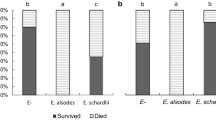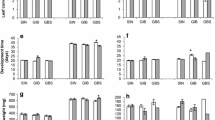Abstract
The larvae of three races of Heliconius erato were fed various species of Passiflora containing varying levels of cyanoglucosides. The mortality rate of larvae and pupae rose when larvae were fed species of Passiflora capable of releasing larger quantities of cyanide. When larvae were fed species of Passiflora with these properties, the resulting adult butterflies also released higher levels of cyanide. This may serve as a defense mechanism. The compounds responsible for the release of cyanide were not evenly distributed throughout the adult butterfly’s body. The thorax contained the highest concentration of cyanogenic substances, followed by the head, wings, and abdomen. The younger tissues of Passiflora plants had higher levels of cyanide-releasing compounds than stems and mature leaves. Cyanogenic glycoside distribution within the plants is consistent with optimal allocation theory. The levels of cyanide-releasing substances in plants varied depending on the season.






Similar content being viewed by others
References
Brako, L. and Zarucchi, J. L. 1993. Catalogue of the flowering plants and gymnosperms of Peru. Syst. Bot. Missouri Bot. Gard. 45:I–XI, 1–1286.
Brattsten, L. B. 1979. Biochemical defense mechanisms in herbivores against plant allelochemicals, pp. 199–270, in G. A. Rosenthal and D. H. Janzen (eds.). Herbivores, Their Interactions with Secondary Plant Metabolites. Academic Press, New York.
Brinker, A. M. and Seigler, D. S. 1989. Methods for the detection and quantitative determination of cyanide in plant material. Phytochem. Bull. 21:24–31.
Brinker, A. M. and Seigler, D. S. 1992. Determination of cyanide and cyanogenic glycosides from plants, pp. 360–381, in H. F. Linskens and J. F. Jackson (eds.). Plant Toxin Analysis. Springer, Berlin Heidelberg New York.
Brower, L. P. and Glazier, S. C. 1975. Localization of heart poisons in the monarch butterfly. Science 188:19–25.
Brower, L. P., Brower, J. V. Z., and Corvino, J. M. 1967. Plant poisons in a terrestrial food chain. Proc. Natl. Acad. Sci. U.S.A. 57:893–898.
Chai, P. 1988. Wing coloration of free-flying Neotropical butterflies as a signal learned by specialized avian predator. Biotropica 20:20–30.
Chai, P. 1996. Butterfly visual characteristics and ontogeny of responses to butterflies by a specialized tropical bird. Biol. J. Linn. Soc. 59:166–189.
Conn, E. E. 1981. Cyanogenic glycosides, pp. 479–499, in E. E. Conn (ed.). The Biochemistry of Plants. A Comprehensive Treatise, Vol 7, Secondary Plant Products. Academic Press, New York.
Cooper-driver, G., Finch, S., Swain, T., and Bernays, E. 1977. Seasonal variation in secondary plants compounds in relation to the palatability of Pteridium aquilinum. Biochem. Syst. Ecol. 5:177–183.
Davis, R. H. and Nahrstedt, A. 1985. Cyanogenesis in insects, pp. 635–654, in G. A. Kerkut and L. I. Gilbert (ed.). Comprehensive Insect Physiology, Biochemistry and Pharmacology II. Pharmacology. Pergamon Press, Oxford.
Ellis, W. M., Keymer, R. J., and Jones, D. A. 1977. The effect of temperature on the polymorphism of cyanogenesis in Lotus corniculatus L. Heredity 38:339–347.
Haribal, M. and Renwick, J. A. A. 2001. Seasonal and population variation in flavonoid and alliarinoside content of Alliaria petiolata. J. Chem. Ecol. 27:1585–1594.
Hay-roe, M. M. 2004. Comparative processing of cyanogenic glycosides and a novel cyanide inhibitory enzyme in Heliconius butterflies (Lepidoptera: Nymphalidae: Heliconiinae). Ph.D. dissertation, University of Florida, Gainesville.
Höesel, W. 1981. The enzymatic hydrolysis of cyanogenic glycosides, pp. 217–232, in B. Vennesland, E. E. Conn, C. Knowles, J. Westley, and F. Wissing (eds.). Cyanide in Biology. Academic Press, London.
Huheey, J. E. 1976. Studies in warning coloration and mimicry. VII. Evolutionary consequences of Batesian–Müllerian spectrum: a model for Müllerian mimicry. Evolution 30:86–93.
Jones, D. A. and Rammani, A. D. 1985. Altruism and movement of plants. Evol. Theory 7:143–148.
Kokko, H., Mappes, J., and Lindström, L. 2003. Alternative prey can change model-mimic dynamics between parasitism and mutualism. Ecol. Lett. 6:1068–1076.
Lambert, J. L., Ramasamy, J., and Paulstellis, J. V. 1975. Stable reagents for the colorimetric determination of cyanide by modified König reactions. Anal. Chem. 47:916–918.
Lindroth, R. L. and Weisbrod, A. V. 1991. Genetic variation in response of the gypsy moth to aspen phenolic glycosides. Biochem. Syst. Ecol. 19:97–103.
Mallet, J. 1999. Causes and consequences of a lack of coevolution in Mullerian mimicry. Evol. Ecol. 13:777–806.
Mallet, J. and Joron, M. 1999. Evolution of diversity in warning color and mimicry: polymorphisms, shifting balance, and speciation. Annu. Rev. Ecol. Syst. 30:201–233.
McKey, D. 1974. Adaptive patterns in alkaloid physiology. Am. Nat. 108:305–320.
Nahrstedt, A. and Davis, R. H. 1983. Occurrence, variation, and biosynthesis of the cyanogenic glucosides linamarin and lotaustralin in the species of Heliconiini (Insects: Lepidoptera). Comp. Biochem. Physiol. 75B:65–73.
Nahrstedt, A. and Davis, R. H. 1985. Biosynthesis and quantitative relationships of the cyanogenic glycosides, linamarin and lotaustralin, in genera of the Heliconiini (Insecta: Lepidoptera). Comp. Biochem. Physiol. 82B:745–749.
Olafsdottir, E. S., Cornett, C., and Jaroszewski, J. W. 1989. Cyclopentenoid cyanohydrin glycosides with unusual sugar residues. Acta Chem. Scand. 43:51–55.
Pough, H., Brower, L., Meck, R., and Kessell, S. R. 1973. Theoretical investigations of automimicry: multiple trial learning and the palatability spectrum. Proc. Natl. Acad. Sci. U.S.A. 70:2261–2265.
Rammani, A. D. and Jones, D. A. 1985. Flexibility in cyanogenic phenotype of Lotus corniculatus L. in response to low fluctuating temperatures. Pak. J. Bot. 17:9–23.
Rothschild, M. 1984. Aide mémoire mimicry. Ecol. Entomol. 9:311–319.
Speed, M. P. and Turner, J. R. G. 1999. Learning and memory in mimicry: II. Do we understand the mimicry spectrum? Biol. J. Linn. Soc. 67:281–312.
Spencer, K. C. 1988. Chemical mediation of coevolution in the Passiflora–Heliconius interaction, pp. 167–240, in K. C. Spencer (ed.). Chemical Mediation of Coevolution. Academic Press, New York.
Srygley, R. B. and Chai, P. 1990. Flight morphology of Neotropical butterflies: palatability and distribution of mass to the thorax and abdomen. Oecologia 84:491–499.
Zar, J. H. 1996. Biostatistical Analysis, 3rd edn. Prentice Hall, Upper Saddle River, NJ.
Acknowledgements
This study constitutes part of a University of Florida doctoral dissertation. MMHR thanks the following for help and encouragement: T. C. Emmel, F. Slansky, H. McAuslane, and D. Jones as members of my committee; C. Jiggins and M. Beltran for hospitality while in Panama; the Delores A. Auzenne Graduate Scholars Fellowship, the James & Margaret Gahan Scholarship, and the John A. Mülrennan Senior Scholarship at the University of Florida for financial support; Butterfly World; and the Association of Tropical Lepidoptera for travel grants to Tingo Maria, Huanuco, Peru, and Panama. We thank the Instituto de Recursos Naturales, Ministerio de Agricultura, Peru; the Smithsonian Tropical Research Institute, Panama; and the United States Department of Agriculture for collecting, exporting, and importing permits.
Author information
Authors and Affiliations
Corresponding author
Additional information
An erratum to this article is available at http://dx.doi.org/10.1007/s10886-008-9465-8.
Rights and permissions
About this article
Cite this article
Hay-Roe, M.M., Nation, J. Spectrum of Cyanide Toxicity and Allocation in Heliconius erato and Passiflora Host Plants. J Chem Ecol 33, 319–329 (2007). https://doi.org/10.1007/s10886-006-9234-5
Received:
Accepted:
Published:
Issue Date:
DOI: https://doi.org/10.1007/s10886-006-9234-5




